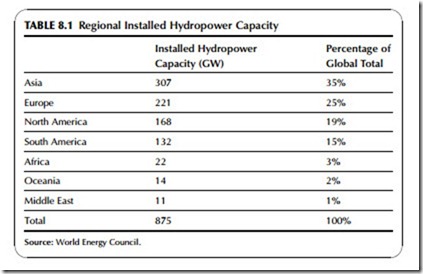Hydropower is probably the oldest renewable energy resource in the world and one of the first sources of mechanical power. The earliest known reference is found in a Greek poem from 85 BCE and there are references in Roman texts too. Simple wheels used to drive mills and grind grain were known in China during the 1st century, and by the beginning of the second millennium the tech- nology was widely known throughout Asia and Europe.
Early mills used wooden paddles but iron was introduced in the 18th century during the Industrial Revolution in England. Innovation soon led to the development during the 19th century of many of the turbines now in use in modern hydropower stations.
Hydropower capacity grew strongly during the 20th century and until late in that century it was the only significant renewable source of electrical power. According to the Renewable Energy Policy Network for the 21st Century (REN21) Global Status Report for 20131 total global hydropower capacity at the end of 2012 was 990 GW excluding pumped storage hydropower capacity. This is an increase of 115 GW compared to the estimate of global capacity from the World Energy Council for the end of 2008 of 875 GW, as shown in Table 8.1. According to the International Hydropower Association, global capacity includes at least 11,000 power stations and 27,000 generating units. REN21 put total global electricity generation from hydropower in 2012 at 3700 TWh, around 15.5% of total global electricity generation, which stood at 22,500 TWh in 2012 according to the BP Statistical Review of World Energy.
Hydropower is widely distributed and few regions are without significant hydropower potential. The countries of the developed world have exploited many of their best sites already and hydropower generation forms part of the bedrock upon which developed nations’ prosperity is based. Development else- where has been slower but there have been major advances in Asia, particularly in China, in recent years, and many of the countries of South America rely heavily on hydropower for electricity generation. Even so, most of these regions have much remaining capacity, while in Africa hydropower is significantly underdeveloped. Table 8.1 shows the breakdown of global capacity at the
end of 2008 based on figures from the World Energy Council’s 2010 Survey of Energy Resources.
In spite of its potential and obvious advantages, the development of hydro- power can often be difficult, particularly where large projects are concerned. Major hydropower projects are often extremely disruptive and, if not developed sensitively, they can lead to a range of environmental problems. Large hydro- power plants, particularly those involving dams and reservoirs, will inevitably change the environment in which they are constructed, leading to displacement of people and wildlife and the destruction of ecologies. With care these changes can be managed, but careless and sometimes reckless development during the second half of the 20th century led to hydropower acquiring a bad reputation during the 1980s and 1990s.
Since then the industry has made an effort to reform its practices, and the World Commission on Dams addressed the main problems in Dams and Development: A New Framework for Decision Making.2 This report proposed a complete reassessment of the criteria and methods used to determine whether a large hydropower project should be constructed. It also laid out an approach to decision making that took account of all the environmental and human rights issues that a project might raise—an approach that should potentially filter out bad projects but allow well-conceived projects to proceed.
When projects are well designed and construction is carried out carefully, large hydropower schemes have the potential to transform the lives of those who benefit from them. Many such schemes provide water for irrigation and drinking as well as power, and they can allow new industries to be established too.
Economically hydropower is considered expensive to build but, when accounted for correctly, it can become one of the cheapest sources of electricity available. Since 2000, the introduction of large quantities of renewable generation from wind and solar power have also led to the recognition that hydro- power has an important role to play in the balancing of intermittent renewable generation on grid systems. This is leading to a further reassessment of the role of hydropower. Pumped storage hydropower plants, which are large energy storage plants based on hydrotechnology, can be used to store energy from renewable plants for use when needed. However, conventional hydro- power can provide significant grid support for other renewable generation too.
Large hydropower projects—those over 30 MW is size—are not generally considered by regulatory authorities to be new renewable generation and in most regions do not attract support such as grants, special tariffs, or tax breaks. However, smaller hydropower schemes, which are generally classified as “small hydropower,” will often be included among the technologies that attract such support mechanisms. These smaller schemes are also less disruptive than their larger relatives and are consequently much easier to build.
